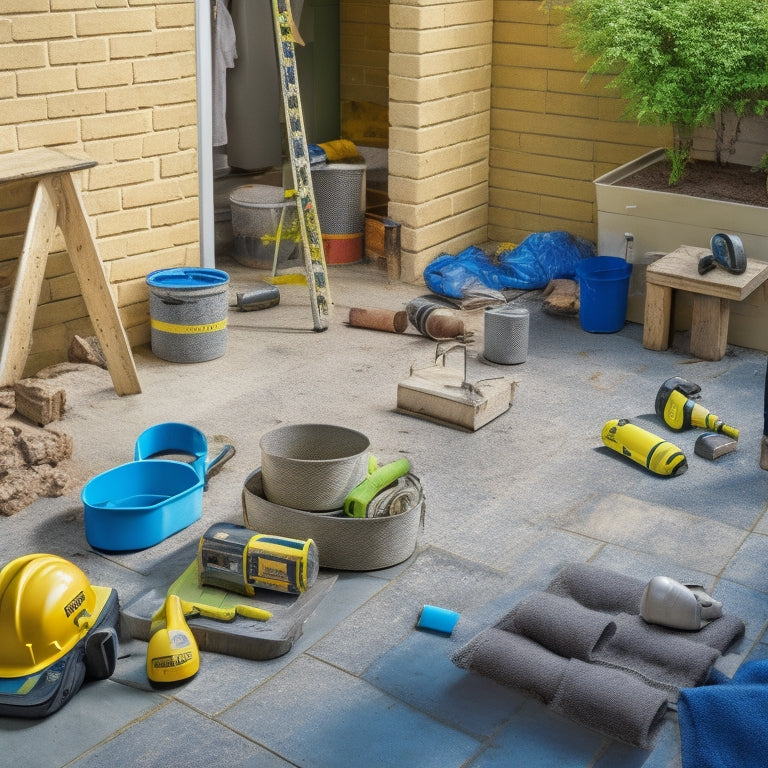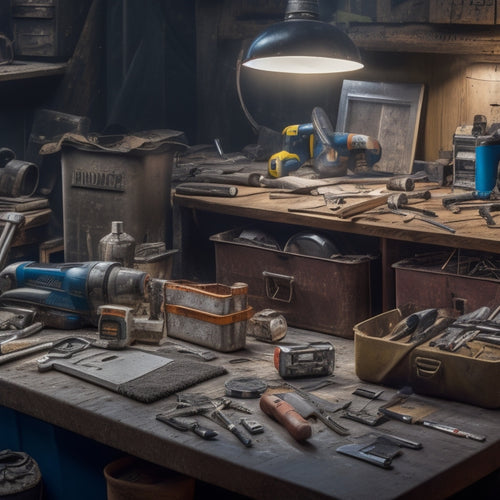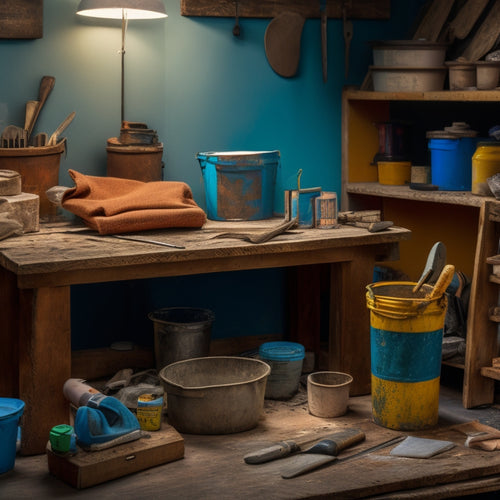
7 Patio Safety Tips for DIY Renovation Projects
Share
As you begin your DIY patio renovation project, prioritize safety by evaluating the worksite for tripping hazards and removing clutter. Wear protective gear, like durable gloves and sturdy shoes, and handle cinder blocks carefully to prevent accidents. Prevent trips and falls by securing loose materials and marking hazardous areas with bright-colored tape or cones. Manage power tool risks by inspecting them regularly, and avoid overexertion injuries by prioritizing hydration and taking regular breaks. Finally, conduct daily worksite inspections to identify potential hazards, and by following these initial steps, you'll be well on your way to a safe and successful patio renovation project, with even more essential details waiting to be uncovered.
Key Takeaways
- Assess the patio worksite for safety, removing tripping hazards and ensuring sufficient space for movement and tool accessibility.
- Wear protective gear, including eyewear, gloves, dust masks, and sturdy shoes, to prevent injuries and exposure to hazardous materials.
- Handle heavy materials like cinder blocks carefully, maintaining a firm grip and stable stance to prevent accidents and injuries.
- Mark hazardous areas with bright-colored tape or cones to alert workers to potential dangers and prevent trips and falls.
- Conduct daily worksite inspections to identify and address potential hazards, ensuring the patio renovation project is completed safely and efficiently.
Prepare the Worksite Safely
Before you begin your patio renovation project, take a step back to assess your worksite and verify it's safe to work on. A well-organized worksite layout is essential for a successful and injury-free project.
Identify any tripping hazards, such as loose cords or uneven surfaces, and remove them immediately. Ascertain there's sufficient space to move around and that all tools and materials are easily accessible.
Next, focus on tool organization. Designate a specific area for your tools and keep them tidy and organized. This will prevent you from misplacing them and reduce the risk of accidents.
Label each tool and store them in a logical order, making it easy to find what you need when you need it. A well-organized worksite will help you stay focused and avoid distractions, allowing you to complete your project efficiently and safely.
Wear Protective Gear Always
Your patio renovation project requires you to wear protective gear at all times.
You're working with power tools, heavy materials, and potentially hazardous substances, so it's essential to shield yourself from harm. Start with protective eyewear, which should have shatter-resistant lenses and a snug, comfortable fit. This will prevent debris, dust, or chemicals from getting in your eyes and causing serious damage.
Next, put on durable gloves that provide grip, flexibility, and protection from cuts, abrasions, and punctures. These will help you maintain control of tools and materials while preventing injuries to your hands.
Don't forget to wear a dust mask or respirator when working with materials that generate fine particles or toxic fumes. This will protect your lungs from irritation and long-term damage.
Finally, wear sturdy, closed-toe shoes or boots with good traction to prevent slips and trips.
Handle Cinder Blocks Carefully
When working with cinder blocks, you'll need to take into account their weight, as a single block can weigh up to 40 pounds, making it vital to plan your lifting strategy.
You'll also need to prevent blocks from shifting during transport or storage, which can lead to accidents and injuries.
Block Weight Considerations
Cinder blocks, weighing in at a hefty 35-50 pounds each, demand careful handling to avoid injuries and property damage during your DIY patio renovation project.
You'll need to take into account the block density, which affects the overall weight and stability of your patio structure. A higher block density means a heavier block, so it's important to factor this into your load distribution calculations.
When handling cinder blocks, make sure you have a firm grip and a stable stance. You should lift with your legs, not your back, to avoid straining your muscles.
It's also vital to maintain control of the block as you move it into position, as a dropped block can cause damage to surrounding structures or injure bystanders.
When stacking blocks, make certain they're aligned properly and the load is evenly distributed to prevent shifting or toppling.
Preventing Block Shift
Properly aligned blocks are essential to preventing patio structure collapse, and it starts with handling cinder blocks carefully. When you're building a patio, every block matters, and slight misalignments can add up to catastrophic consequences.
To guarantee block alignment, you'll need to focus on foundation stability from the get-go. Start by laying a level foundation, ensuring the ground is compact and even. As you begin building, make sure each block is aligned with the one below it, using a spirit level to double-check your work.
When placing blocks, avoid applying excessive pressure, which can cause them to shift out of position. Instead, gently tap each block into place, using a rubber mallet to avoid damaging the surface.
As you add more blocks, regularly inspect the structure to catch any signs of shift or instability. By maintaining precise block alignment and a solid foundation, you'll create a patio that's both safe and structurally sound.
Safe Lifting Techniques
You've taken great care to align your blocks, but now it's time to focus on the physical demands of patio building. Handling cinder blocks requires attention to safe lifting techniques to avoid injury.
When lifting, maintain proper posture by standing with your feet shoulder-width apart, knees slightly bent, and back straight. This stance will help distribute the load evenly, reducing strain on your back and joints.
As you lift, keep the block close to your body, with your hands positioned at opposite corners to achieve ideal load distribution. Avoid twisting or turning while lifting, as this can put unnecessary stress on your spine. Instead, pivot on your feet to change direction.
When setting the block down, bend at the knees and use your leg muscles to lower it slowly, keeping control throughout the process. By following these safe lifting techniques, you'll be able to handle cinder blocks with confidence and protect yourself from injury.
Prevent Trips and Falls
As you work on your patio renovation, you'll need to take steps to prevent trips and falls, which can be costly and even dangerous.
Start by clearing the clutter from your workspace, securing loose materials that could shift or topple, and marking hazardous areas like uneven terrain or slippery surfaces.
Clear the Clutter
How cluttered is your patio renovation workspace? A cluttered workspace is an accident waiting to happen. Tripping hazards, falling objects, and misplacing essential tools can slow down your project and put you at risk.
Clearing the clutter is essential to prevent trips and falls.
To maintain a safe and organized workspace, incorporate these decluttering strategies:
| Strategy | Organizing Tools |
| Remove unwanted materials | Trash bags, dumpsters |
| Designate a tool zone | Toolboxes, pegboards |
| Label and categorize materials | Labels, bins, shelves |
Keep your patio renovation workspace organized by regularly removing unnecessary materials, designating a specific area for tools, and labeling materials.
This will help you quickly find what you need, reduce tripping hazards, and prevent falls.
Secure Loose Materials
Loose materials scattered around your patio renovation workspace pose a significant tripping hazard, putting you at risk of falls and injuries.
As you work on your DIY project, it's crucial to secure loose materials to prevent accidents.
To guarantee a safe working environment, follow these steps:
-
Designate a material storage area: Choose a dry, covered spot away from foot traffic to store materials, tools, and equipment. This will keep your workspace clear and reduce the risk of tripping.
-
Consider weather conditions: If you're working outdoors, be prepared for changing weather conditions. Cover materials and equipment with waterproof covers or tarps to prevent water damage and slippery surfaces.
-
Store materials off the ground: Keep materials elevated on pallets, shelving, or racks to prevent water accumulation and reduce the risk of tripping over them.
Mark Hazardous Areas
Tripping hazards can be hidden in plain sight, making it crucial to identify and mark them clearly to prevent accidents. As you assess your patio renovation project, conduct a thorough hazard identification process to pinpoint potential tripping hazards, such as uneven pavers, loose decking, and protruding nails.
Once you've identified these hazards, use area marking to clearly indicate their presence. Use bright-colored tape, cones, or signs to create a visual barrier that alerts you and others to the potential danger.
When marking hazardous areas, consider the flow of traffic on your patio. Identify the most frequently used paths and mark hazards accordingly. Ascertain that your markings are highly visible, even in low-light conditions.
Don't rely on memory alone; instead, use area marking to create a physical reminder of potential tripping hazards. By taking these steps, you'll greatly reduce the risk of trips and falls, allowing you to focus on completing your patio renovation project safely and efficiently.
Manage Power Tool Risks
Operating power tools on your patio renovation project demands attention to safety protocols to prevent accidents.
You're working with powerful machines that can cause serious harm if not handled properly. To manage power tool risks, focus on tool maintenance and power source safety.
Regularly inspect your power tools for signs of wear and tear, such as frayed cords or damaged blades.
Make sure to follow the manufacturer's maintenance instructions to keep your tools in good working condition.
When it comes to power source safety, remember to:
- Keep cords away from water: Avoid using power tools near water or in humid conditions to prevent electrical shock.
- Use the right extension cord: Choose an extension cord that's rated for outdoor use and can handle the power load of your tools.
- Avoid overheating: Take regular breaks to give your tools a chance to cool down, and never leave them unattended while they're still running.
Avoid Overexertion Injuries
As you tackle your patio renovation project, you're likely to encounter physically demanding tasks that push your body to its limits.
It's crucial to recognize your physical limitations and take proactive measures to avoid overexertion injuries. To prevent exhaustion, prioritize proper hydration by drinking plenty of water throughout the day. Aim to consume at least 8-10 glasses of water, especially when working in hot or humid conditions.
Additionally, take regular rest breaks to give your body a chance to recover. Schedule breaks every 60-90 minutes to stretch, move around, and rest your muscles. This will help reduce muscle fatigue, improving your overall performance and reducing the risk of injury.
When lifting heavy objects, use proper lifting techniques to avoid straining your back. Bend at the knees, keep the object close to your body, and lift with your legs rather than your back.
Inspect Worksite Daily
You've prepared your body for the physical demands of your patio renovation project, now it's time to assure your worksite is safe and secure. Daily inspections are essential to identify potential hazards and prevent accidents.
As you begin each day, take a few minutes to survey your worksite, confirming it's clean, organized, and free from obstacles.
Check for the following during your daily inspections:
- Tripping hazards: Ascertain cords, wires, and equipment are properly secured and out of walkways.
- Fall risks: Verify ladders, scaffolding, and elevated surfaces are stable and securely positioned.
- Debris and obstacles: Remove any debris, tools, or materials that could cause tripping or falling.
Maintaining a clean and organized worksite not only reduces the risk of accidents but also boosts productivity and efficiency.
By incorporating daily inspections into your renovation routine, you'll be able to identify and address potential hazards before they cause harm.
Frequently Asked Questions
Can I Renovate My Patio if I Have a Small Child or Pet at Home?
When renovating with a small child or pet at home, you must prioritize child safety and pet precautions, ensuring a secure environment by securing hazardous materials, blocking off areas, and supervising their access to the renovation zone.
How Do I Handle Neighbors Who Complain About Noise and Mess?
Did you know 75% of neighborly disputes stem from noise complaints? You'll avoid being a statistic by implementing noise mitigation strategies, like sound barriers and scheduling, and employing effective communication techniques, like regular updates and open dialogue, to keep your neighbors in the loop.
What if I Find Asbestos or Lead Paint During the Renovation?
When you uncover asbestos or lead paint, stop work immediately and don't disturb the material. You'll need to hire a certified professional for asbestos testing and lead paint remediation to guarantee safe, compliant removal and disposal.
Can I Reuse Old Patio Materials to Save Money and Reduce Waste?
You'll be tossing a small fortune down the drain if you don't explore cost-effective options! Reusing old patio materials can be a goldmine for sustainable practices, but first, inspect them meticulously to verify they're safe, sturdy, and worth repurposing.
Should I Hire a Professional for Certain Parts of the Project?
When tackling a complex project, you'll need to weigh cost considerations: if you're not experienced in specialized areas like electrical or plumbing, it's often cheaper and safer to hire a pro, even if it means sacrificing some DIY pride.
Conclusion
You've made it to the final stretch of your patio DIY renovation project! As you put the finishing touches, remember that safety is an ongoing process. According to the National Safety Council, falls from ladders are a leading cause of injury, with over 500,000 incidents annually. Stay vigilant and avoid becoming a statistic. By following these 7 patio safety tips, you'll guarantee a successful and injury-free project. Now, take a step back, admire your handiwork, and enjoy your new outdoor space!
Related Posts
-

Smart Guide to Buying Second-Hand Renovation Tools
When buying second-hand renovation tools, you'll want to set clear renovation goals and a realistic budget to priorit...
-

5 Must-Have Plastering Tools for Safe Renovation
You'll need a range of essential tools to tackle your plastering project safely. Invest in a variety of trowels, incl...
-

DIY Plastering Supply Checklist for Home Renovation
To tackle a DIY plastering project for your home renovation, you'll need a solid checklist of supplies. Start with es...


